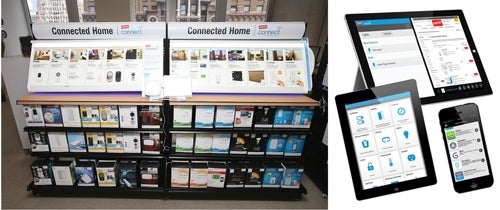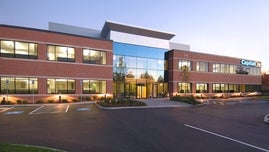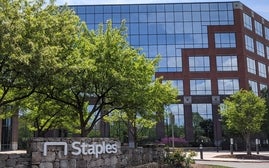Staples looks for a lift from 'Connect'
Staples has been in desperate need of a shot in the arm.
Its profits tumbled 43 percent in the most recent quarter, as the Framingham-based office supply retailer began to implement a plan to close 225 of its nearly 1,850 North American stores by the end of 2015.
But salvation could come in the form of Staples Connect, a home and office automation platform that allows users to unlock a door, turn on the lights and raise the air conditioning with a single mobile application.
After a nine-month, 30-store pilot, Staples Connect in-store displays were rolled out in late July across 500 stores nationwide, including locations in Framingham, Milford, Sturbridge, Westborough and Worcester. The basic package is available for $49, and can support 150 automated products from 38 manufacturers such as Philips, Honeywell and General Electric.
“We're very pleased with the initial results,” said Brian Coupland, vice president of new business development. “We think this is a really exciting new category.”
From using pre-existing templates to ensure automated devices are ready for consumer use, to aggregating dozens of devices under a single app, to testing individual product apps for functionality, Central Massachusetts companies are getting in on many phases of the growing automation market.
Automation — centralized control of devices and systems in a home or business to provide added convenience, energy efficiency or security — has spent most of its two decades in the wilderness as the domain of tech geeks or the extremely wealthy.
But with the spread of smartphones and tablets, automation can now enable people to check and control their home or office while on the go, resulting in more mainstream adoption over the past two or three years.
“You can put together a really complete picture of what's going on in a house without actually seeing the home,” said Greg Charland, president of Charland Technology, a technology services provider in Hubbardston.
Still, it's a relatively nascent market.
IDC: Interest is growing
More than half of the 1,521 people surveyed in the spring by Framingham-based technology research firm IDC said they would be very interested in having automated sensors monitor for fire, smoke, water or carbon dioxide in their homes, as well as using automated security cameras to report on activity around the exteriors or entrances of their homes. But less than four percent of respondents already had automated devices for these purposes.
“It's gone beyond an academic research phase, and we're starting to see it commercialized,” said Matt Johnston, chief marketing and strategy officer at Framingham-based Applause (formerly uTest), which tests automation apps.
But experts warn that “smart” home or office products are unlikely to catch on quickly. From a lack of apparent benefits to difficult setup and installation processes to potential security risks, there are plenty of possible pitfalls.
“The home automation products we have now are not really solving issues people have a problem with,” said Jonathan Gaw, an IDC research manager.
Ansar Kassim, head of mobility at Westborough-based Virtusa, said he thought the automation market would be more mature by this point, with certain companies gaining a dominant foothold.
“I'm concerned that the market is not coming together,” said Kassim, whose company works with manufacturers and customers to make sure automation products are ready for general use. “There needs to be some structure, particularly from a security angle.”
Kassim said users shouldn't have to layer automated devices, security products and installation programs on top of one another to get a safe and functional experience.
“If you want (to get) into your house, your air conditioner should turn on, and if you walk out of your home, your air conditioner should turn off,” he said.
Making them work together
Johnston also said lack of interoperability is the biggest obstacle facing the automation market today, with different apps needed to control the light, heat and security systems.
And with new manufacturing entering the market and existing manufacturers introducing both new automated product lines and updated versions of existing products, Johnston expects fragmentation to get worse before it gets better.
But Coupland expects Staples Connect to help address this festering issue.
During the pilot period, the company said it found the typical Staples Connect user had seven automated devices associated with his or her account, and interacted with the app about eight times per day. The average customer visit to the app lasted one minute and 40 seconds, according to Staples.
Scott Tilghman, a Boston-based analyst covering Staples for the investment firm B. Riley & Co., said business owners seem to have an appetite for automated products.
Although upfront installation costs for automated devices are higher, Tilghman said they can yield savings in the long run by allowing companies to better manage their utility and security expenses.
The challenge, though, will be getting the company's sales associates to understand as thoroughly as possible what automation offers so they can convince business owners of its benefits.
“It's easy to sell a pencil and some paper, but when you get into technology, it's a different process,” he said.
Coupland said Staples will employ a multi-pronged approach — including training for sales associates — to make sure potential customers are aware of what Staples Connect can do for them.
Although Tilghman sees Staples Connect as another step in turning the company into more of a business supply house, he doesn't anticipate it will pay dividends right away.
“In the near term, it's not going to be a needle mover,” he said.














0 Comments